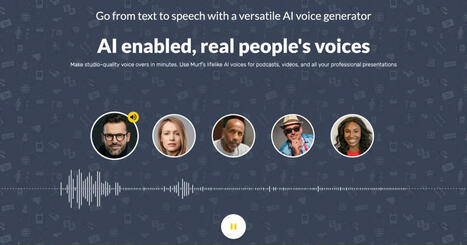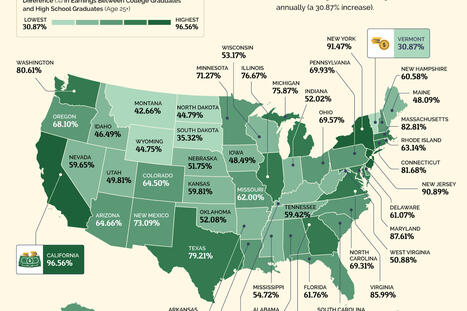Evan, a high school sophomore from Houston, was stuck on a calculus problem.He pulled up Answer AI on his iPhone, snapped a photo of the problem from his...
Get Started for FREE
Sign up with Facebook Sign up with X
I don't have a Facebook or a X account
 Your new post is loading... Your new post is loading...
 Your new post is loading... Your new post is loading...

Charles Tiayon's curator insight,
April 28, 2024 12:57 AM
"Fri, April 26, 2024 at 3:26 p.m. GMT+1·4 min read The innovative AI-powered mobile calling app further boasts real-time speech translation capabilities, empowering users to call globally like a local in their native languages. SAN JOSE, CA / ACCESSWIRE / April 26, 2024 / AI Phone, the leading generative AI-powered mobile application for enhanced phone calls, today announced a major update that expands its real-time phone translation capabilities to 91 languages and dialects, far surpassing other solutions on the market. For instance, the Samsung Galaxy S24's Live Translate for phone calls supports only 13 languages upon release. Additionally, AI Phone's speech-to-text feature now supports 133 languages. It also excels in recognizing dialects for phone voice recognition, supporting up to 14 dialects of Arabic, 22 dialects of Spanish, and 15 English dialects and accents. This significant advancement empowers users to overcome language barriers and connect seamlessly worldwide, fostering a more inclusive and globalized communication experience. By fine-tuning LLM for phone call scenarios and contexts, the translation accuracy has reached 98%, far surpassing that of ordinary text translation techniques. AI Phone app is available on the App Store and Google Play. Learn more about AI Phone's suite of features and unlock a world of effortless communication at aiphone.ai. Bridging the Gap: Effortless Communication Across Languages As the first app to truly apply AI large models to the field of real-time phone translation, AI Phone leverages the power of artificial intelligence to revolutionize phone calls. The app provides a comprehensive suite of features, including real-time call translation in both texts and speech, live call captioning, AI-powered call summaries, and comprehensive transcriptions. This recent update focuses on real-time translation, removing the frustration of language barriers for a wider range of users. "We are thrilled to expand our real-time call translation capabilities to more languages," said Rachel Davis, Senior Public Relations and Communication Manager at AI Phone. "This update reflects our commitment to making communication accessible and fostering connections across borders. Whether you're a seasoned globetrotter, a business professional navigating international partnerships, or someone simply wanting to connect with loved ones who speak another language, AI Phone empowers you to have clear and effortless conversations." Addressing Communication Challenges in Diverse Scenarios AI Phone's real-time translation addresses communication challenges in a variety of scenarios: Global Travel: Effortlessly navigate conversations with locals, ask for directions, or order food with confidence, regardless of the language spoken. Cross-Border Business Trips: Facilitate smooth communication during conference calls, or casual conversations with international colleagues. Multinational Company Collaboration: Bridge communication gaps within diverse teams, fostering a more inclusive and productive work environment. Non-Native Speakers: Stay connected with family and friends who speak a different language, or confidently conduct business calls in your non-native tongue. International students can also benefit by overcoming language hurdles while adapting to a new environment. Why Choose AI Phone? AI Phone prioritizes user experience. The app boasts a simple and intuitive interface, making it easy for users of all technical backgrounds to access its powerful features. With a few taps, you can activate real-time translation and enjoy seamless communication across language barriers. AI Phone also stands out with its unique combination of features and benefits: Cost-Effective: Affordable subscription plans make AI Phone's powerful features accessible to everyone. Compared to traditional human interpretation solutions, it saves over 99% of the cost. Multi-System Compatibility: The app seamlessly integrates with both iOS and Android devices, ensuring everyone has access to this innovative technology. All-in-One Functionality: Eliminate the need to juggle multiple apps or devices. AI Phone provides a comprehensive suite of features within one user-friendly platform. The Future of Telephone Communication AI Phone represents the future of phone calls. By harnessing the power of AI, the app transforms traditional phone calls into a more inclusive and efficient communication tool. "We are dedicated to continuous development, adding even more languages in the future, and exploring new ways to leverage AI to enhance the phone call experience for everyone," Rachel Davis added. Experience the future of communication by downloading AI Phone for free from the Apple App Store and Google Play. Visit aiphone.ai for more information. About AI Phone AI Phone is a generative AI-powered mobile application that empowers users to have clear and effortless phone calls through a suite of AI-powered features, including real-time call translation, call transcriptions with highlighted notes, and AI call summaries. AI Phone is committed to making communication smarter and fostering connections across borders. For more information, please visit aiphone.ai. Media Contact Company: AI Phone SOURCE: AI Phone" #metaglossia_mundus |

Gust MEES's curator insight,
September 11, 2024 2:24 PM
It’s not just your students, people across the globe and professions really don’t like to think.
https://www.scoop.it/topic/21st-century-learning-and-teaching?tag=Research
victoriainfantilgerindote@gmail.com's comment,
December 9, 2024 1:02 PM
Los profesores debemos cambiar la metodología en el aula, haciendo que el alumnado disfrute del aprendizaje, conociendo qué les motiva y enseñando contenidos que puedan aplicar a su día a día
lyciaaderaputri@gmail.com's comment,
December 21, 2024 4:53 PM
slot gacor ����� terbaru ter panas ��� tergokil �
ANTI RUNGKATTTTT JAMIN GACOR 98 PERSEN !!!! GAS KAN KE LEMACAU PALING GACOR ��� �lemacau90m.net � rebrand.ly/Lemacauhoki Situs casino online menyediakan beberapa jenis permainan Judi Casino diantaranya: BACCARAT, SLOT GAMES, ROULETTE, SICBO dan masih banyak lagi. Selain itu anda juga bisa menikmati keuntungan dengan memainkan semua jenis permainan dengan hanya 1 akun saja

Charles Tiayon's curator insight,
August 13, 2024 12:49 AM
"Harnessing AI to Preserve the World’s Endangered Languages IntroductionThe world’s linguistic diversity is under threat. According to UNESCO, over 40% of the approximately 7,000 languages spoken globally are endangered, with many at risk of disappearing forever. As globalization and the dominance of major world languages like English, Mandarin, and Spanish continue to grow, the race is on to preserve the unique cultural treasures embodied in these minority tongues before they are lost to future generations. Fortunately, advances in artificial intelligence (AI) and machine learning are providing powerful new tools in the fight to save endangered languages. From high-tech documentation efforts to community-driven language revitalization programs, AI is playing a critical role in reversing the tide of linguistic extinction. In this article, we’ll explore some of the innovative ways that AI is being leveraged to preserve the world’s endangered languages. The Power of AI in Language PreservationAt the heart of the endangered language crisis is a lack of comprehensive data. Many minority and indigenous languages have never been thoroughly documented, with no written grammars, dictionaries, or recorded oral histories available. This lack of linguistic data makes it extremely challenging to develop the educational resources, language-learning tools, and computational applications needed to support language revitalization efforts. This is where artificial intelligence is creating a significant transformation. Advanced speech recognition, natural language processing, and machine learning algorithms are enabling the rapid digitization and documentation of endangered language materials at unprecedented scales. Researchers are deploying AI-powered audio and video recording devices to capture spoken language data from fluent elders, while AI-assisted transcription and translation tools are allowing this data to be efficiently processed and annotated. One pioneering example is the Endangered Languages Documentation Programme (ELDP) at SOAS University of London. This initiative has used AI-powered recording devices and transcription software to build a vast digital archive of endangered language materials, including over 4,000 hours of audio and video recordings in more than 300 languages. By automating the data collection and processing workflow, the ELDP has been able to significantly accelerate the documentation of these at-risk tongues. Similarly, the Wikitongues project has leveraged AI-powered speech recognition to create an online repository of crowdsourced video recordings of people speaking over 1,000 different languages. This growing digital library allows linguists, educators, and community members to access authentic language data and collaborate on preserving their linguistic heritage. Revitalizing Endangered Languages with AIBeyond just documenting endangered languages, AI is also playing a crucial role in revitalizing them. Intelligent language-learning chatbots, for instance, are being developed to provide interactive, conversational practice for endangered language speakers, particularly younger generations who may not have had the opportunity to learn from fluent elders. These AI assistants can be customized with culturally relevant content and designed to encourage frequent use, helping to foster intergenerational transmission of endangered languages. In New Zealand, the Te Hiku Media organization has created an AI-powered language app called “Te Reo Hāpai” that teaches conversational Māori through interactive games and lessons. Similarly, in Canada, the FirstVoices initiative has developed a suite of mobile apps powered by AI speech recognition that allow Indigenous language learners to practice their skills through voice-enabled activities. Multilingual AI systems are also proving useful for language preservation, as they can facilitate communication and collaboration between speakers of different endangered languages. For example, the Universal Dependencies project is using AI-driven multilingual natural language processing to create vast datasets of syntactically annotated text in over 100 languages, including many at-risk minority tongues. This linguistic data can then be leveraged to build machine translation systems, educational resources, and other computational tools to support endangered language communities. Ethical ConsiderationsOf course, the integration of AI into language preservation efforts also raises important ethical and practical considerations. There are valid concerns about data privacy, intellectual property rights, and the potential for AI-powered tools to be misused or to inadvertently cause harm to vulnerable language communities. Careful design, rigorous testing, and close collaboration with local stakeholders are essential to ensure that AI is deployed responsibly and equitably in this domain. ConclusionThe urgent need to preserve the world’s endangered languages has never been more pressing. With over 40% of the approximately 7,000 languages spoken globally now classified as at-risk, the race is on to document, revitalize, and transmit these vital cultural artifacts to future generations before they disappear forever. Fortunately, the rapid advancement of artificial intelligence (AI) and machine learning technologies is providing powerful new tools to aid in this critical effort. From automated language documentation and digitization to interactive AI-powered language learning apps, the integration of AI into language preservation initiatives is transforming the landscape of endangered language conservation. As we continue to explore the remarkable potential of AI to support endangered language communities, it will be essential to do so in a responsible and ethical manner – one that prioritizes the needs, rights, and cultural autonomy of these vulnerable linguistic groups. Only then can we truly harness the full power of AI to safeguard the rich diversity of human expression and ensure that no language is left behind. You may also like: AI and the Revival of Extinct Languages FAQQ1. What is AI’s role in endangered language preservation?A1. AI is revolutionizing endangered language preservation through technologies like automated language documentation, AI-powered language learning apps, and multilingual AI systems that facilitate communication and collaboration between speakers of different minority languages. Q2. What are some examples of AI-powered language preservation initiatives?A2. Examples include the Endangered Languages Documentation Programmed at SOAS University of London, the Wikitongues project, the Te Reo Hāpai Māori language app in New Zealand, and the First Voices initiative in Canada. Q3. What ethical considerations arise with using AI for language preservation?A3. Key concerns include data privacy, intellectual property rights, and the potential for AI tools to be misused or cause unintended harm to vulnerable language communities. Careful design, rigorous testing, and close collaboration with local stakeholders are essential. Q4. How can AI help reverse the tide of linguistic extinction?A4. By automating and streamlining the documentation, revitalization, and transmission of endangered languages, AI technologies are providing new hope for safeguarding the rich cultural diversity embodied in the world’s minority tongues. Q5. What is the current state of endangered language preservation globally?A5. According to UNESCO, over 40% of the approximately 7,000 languages spoken globally are currently endangered, with many at serious risk of disappearing forever due to factors like globalization and the dominance of major world languages." #metaglossia_mundus: https://itmunch.com/harnessing-ai-to-preserve-endangered-languages/
|


























